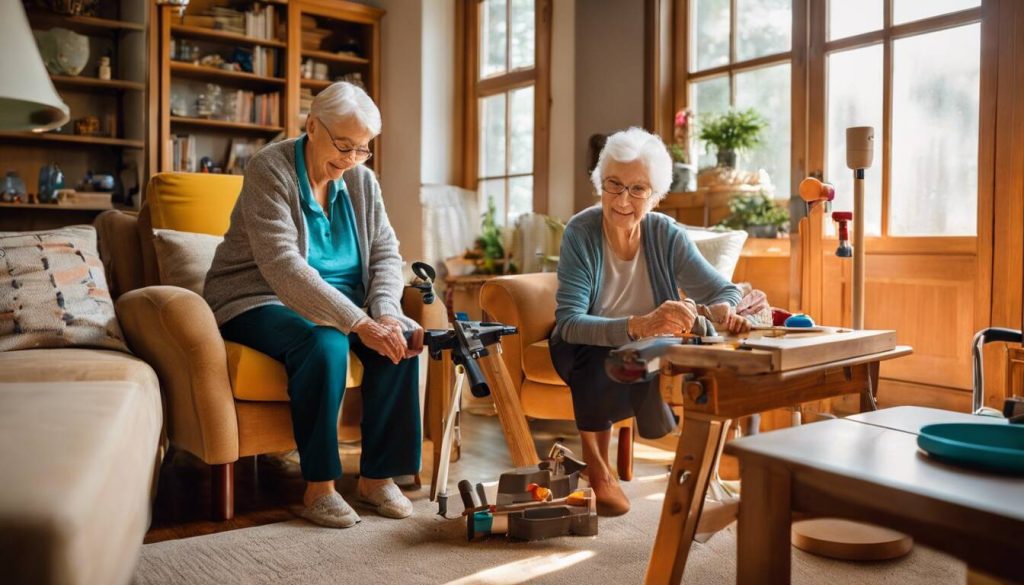The Benefits of Occupational Therapy for Elderly Home Safety
Promoting Independence and Preventing Falls
Occupational therapy aids seniors to skillfully carry out their daily tasks while living safely at home. It adapts practical solutions focusing on their capability to dress, cook, bathe, and move around with minimal assistance, encouraging a sense of independence. Surprisingly, it not only looks after these common tasks but also addresses concerns such as vision impairment and memory loss which are often overlooked.

So, imagine someone working hand-in-hand with you, identifying the dangers in your home while developing pathways to avoid them - that's your friendly occupational therapist right there. On we go then, let's delve deeper into this fascinating world.
Occupational therapy plays a crucial role in enhancing elderly home safety by addressing challenges related to daily activities, fall prevention, vision improvement, and memory enhancement. Through therapeutic interventions and home modifications, occupational therapists empower seniors to navigate their living spaces with independence and confidence.
Defining Occupational Therapy for Elderly Home Safety
Occupational therapy (OT) is a crucial healthcare service tailored to the specific needs of seniors, with the goal of adapting their living spaces and enhancing their abilities to carry out daily tasks. For seniors, maintaining autonomy and living independently is paramount. Occupational therapy plays a pivotal role in improving their capacity to engage in routine activities and navigate around their homes safely.
Occupational therapists are dedicated professionals who work closely with seniors to develop, maintain, or regain the skills essential for carrying out Activities of Daily Living (ADLs). These activities encompass regular tasks such as bathing, dressing, cooking, and moving throughout the home. By addressing these fundamental abilities, occupational therapists play a crucial role in supporting seniors' independence and quality of life as they age in place.
As we age, our bodies undergo changes that may impact our ability to carry out everyday tasks. Simple activities like preparing a meal or taking a shower may become more challenging for older adults due to physical limitations or health conditions. The primary goal of occupational therapy is to facilitate and enhance seniors' engagement in activities that are meaningful and essential to their daily lives.
For example, consider a scenario where a senior faces difficulty in reaching high shelves or bending down to pick up items from the floor. An occupational therapist would evaluate the individual's needs and recommend appropriate strategies or equipment—such as grab bars, reachers, or ergonomic kitchen tools—to facilitate these tasks. Furthermore, therapists may suggest modifications to the home environment, such as rearranging furniture or adding handrails, to ensure safe movement within the residence.
In essence, occupational therapy not only addresses the physical challenges faced by seniors but also seeks to empower them by fostering a sense of capability and self-reliance in their everyday lives.
Now, let's explore how occupational therapy continues to advance elderly safety and well-being within their homes.
Advancing Elderly Safety with Occupational Therapy
Occupational therapy surpasses the mere identification of potential hazards for the elderly; it provides tailored interventions to address a myriad of challenges that seniors may face as they strive to maintain independence and safety in their homes. One of the areas where occupational therapists make a significant impact is fall prevention, which can lead to serious injuries and have a negative impact on the overall well-being of older adults. Occupational therapy shines in mitigating fall risks by developing personalized strategies within the living environment.
Addressing fall prevention isn't the sole focus. Occupational therapists also play a crucial role in addressing issues related to vision impairment and memory loss, which can significantly impact an individual's ability to carry out daily activities and navigate their living space safely. By collaborating with seniors, these professionals identify potential obstacles and develop tailored strategies to enhance safety and functionality within the home.
Let's consider how this is done in real-world scenarios. Imagine an elderly individual experiencing vision impairment struggling to recognize obstacles within their home or facing challenges navigating through dimly lit areas. An occupational therapist will step in, evaluating the home environment and working closely with the individual to recommend modifications such as improved lighting, removal of tripping hazards, or installation of handrails to promote safe mobility.
Moreover, the engagement doesn't end at environmental modifications. Occupational therapists provide comprehensive support by addressing physical limitations affecting the individual’s functional abilities. They offer recommendations for exercises to improve strength, balance, and coordination while also providing guidance on effectively using assistive devices such as canes or walkers.
Consider this: Think of an elderly couple looking to age in place but grappling with mobility challenges that deter them from being fully independent at home. Occupational therapists can provide hands-on training tailored to their specific needs, teaching proper body mechanics and offering valuable insights into using adaptive equipment to carry out daily activities safely and comfortably.
The goal of all these efforts is to empower elderly individuals to live safely and independently within the comfort of their own homes. By addressing not only physical impairments but also environmental factors, occupational therapy plays a crucial role in enhancing the quality of life for seniors, reducing healthcare costs associated with fall-related injuries, and ultimately creating a supportive and secure living environment for aging individuals.
By providing personalized support and maximizing safety measures within the home, occupational therapy brings immeasurable value in enabling seniors to age in place comfortably, empowered by a sense of independence and security.
Moving forward from understanding the pivotal role of occupational therapy in promoting elderly home safety, let's explore how this vital practice enhances everyday functionality for aging individuals.
Enhancing Daily Functionality through Occupational Therapy
 Occupational therapy (OT) isn't just about exercising and strengthening muscles; it's about making those activities easier for seniors to do every day. It focuses on specific tasks vital for their independence, such as brushing their teeth, getting dressed, or preparing a meal. OT interventions are tailored to improve motor skills, strength, dexterity, range of motion, and mobility, enabling seniors to carry out these essential tasks with greater ease and safety.
Occupational therapy (OT) isn't just about exercising and strengthening muscles; it's about making those activities easier for seniors to do every day. It focuses on specific tasks vital for their independence, such as brushing their teeth, getting dressed, or preparing a meal. OT interventions are tailored to improve motor skills, strength, dexterity, range of motion, and mobility, enabling seniors to carry out these essential tasks with greater ease and safety.
Imagine being able to lift a spoon without your hand shaking or reaching for something in a cupboard without feeling wobbly. These seemingly small improvements can make all the difference in preserving an elderly person's dignity and self-reliance.
Key Focus Areas of Occupational Therapy Interventions
Let's break down some of the key areas where occupational therapy can make a significant impact:
- Motor Skills: Occupational therapists work with seniors to enhance their motor skills through exercises and activities geared toward improving muscle coordination, precision, and efficiency in movement.
- Strength & Dexterity: Strengthening exercises help older adults maintain muscle mass and bone density while also improving grip strength and fine motor control, allowing them to tackle daily tasks more effectively.
- Range of Motion: A well-designed occupational therapy program may include exercises that target flexibility and joint mobility to ensure that seniors can move comfortably without pain or restriction.
- Mobility: Mobility aids or devices are often incorporated into the treatment plan to improve seniors' ability to move around safely and independently within their home environments.
Occupational therapists work closely with seniors to address their unique needs, designing personalized interventions aimed at overcoming any limitations and promoting functional independence.
For instance, if an elderly individual is struggling to pour a drink from a heavy pitcher due to reduced arm strength or hand tremors, an occupational therapist may recommend adaptive equipment like a lightweight jug with an ergonomic handle for easier pouring.
By honing in on these fundamental areas, occupational therapy equips seniors with the tools they need to maintain their autonomy in performing everyday activities with confidence and ease.
Shifting our focus from individual interventions, let's now explore how therapeutic assessments play a pivotal role in identifying mobility risks among older adults.
Utilizing Therapeutic Assessments for Mobility Risks
Occupational therapists serve as detectives, carefully examining a person's movement and abilities to uncover challenges and identify potential solutions. The assessments they use not only identify problems but also aim to find proactive solutions.
One of the primary areas occupational therapists focus on is gait, which involves analyzing a person's pace, step length, the possibility of shuffling feet, and leaning patterns. These details provide valuable insights into balance, strength, and coordination.
Balance testing is another crucial aspect. Tests involve activities like standing on one leg or walking in a straight line to assess stability and the likelihood of losing balance.
Assessment of muscle strength is essential too. Occupational therapists evaluate leg and overall muscle strength through activities such as resistance exercises to gauge muscle functionality.
Coordination is an integral part of the assessment process. This includes evaluating activities like quick movements, reaching without losing balance, or grasping surfaces for support.
In addition to examining these factors, occupational therapists pay attention to how well an individual performs each activity and how frequently they can do so before becoming fatigued.
Tailoring Support to Minimize Fall Risks
Once all relevant information has been gathered, occupational therapists can develop a clear plan to minimize fall risks and enhance overall mobility within the home environment.
They may recommend adding grab bars in the bathroom or reorganizing furniture to facilitate easier movement. Additionally, they could suggest personalized exercises or activities aimed at building strength, improving balance, and practicing safe movement—creating a tailored workout plan.
For instance, if someone experiences shaky balance and weak muscles when standing up from a chair, the therapist might advise specific strengthening exercises and safe standing practices.
This approach doesn't just address issues after they occur; it also incorporates preventative measures. By identifying potential problems early through these assessments, occupational therapists can provide intervention and support tailored to each person's unique needs. This approach minimizes risks and ensures that older adults can continue to navigate their homes safely for as long as possible.
In understanding the crucial role of occupational therapy in enhancing home safety for older adults, we now turn our attention to specific strategies that can further promote their well-being and independence.
Strategies for Elderly Home Safety
Making simple changes around the house can significantly impact the safety and independence of our elderly loved ones. Decluttering is a crucial step—clearing away unnecessary items can prevent hazards and make it easier for seniors to move around without stumbling.
Color-coding household items can also be incredibly beneficial. Creating a system of different colors helps seniors easily spot important items, particularly for those with vision impairment or memory loss. Imagine how much easier it would be for them to find something without sifting through piles of similar-looking things!
Improving lighting is another game-changer. A well-lit home reduces the risk of accidental falls, especially during nighttime movements to essential areas like the bathroom or kitchen. Additionally, adding magnifiers for individuals with impaired vision can greatly enhance their ability to see and function better within their living space.
Enhancing lighting and using magnifiers are akin to adjusting the brightness on a smartphone at night—it makes everything clearer and easier to work with. These adjustments enable seniors to see things more clearly and create safer living spaces.
Installing grab bars and implementing slip-resistant flooring in areas like bathrooms and kitchens is another smart move. These additions provide stability and reduce the risk of slipping on wet surfaces, much like how seatbelts in a car keep you safe while driving.
So, these practical strategies not only contribute to a safer living environment but also promote independence among seniors, providing reassurance that they have the necessary aides in place to feel confident moving around on their own.
With these safety measures in place, seniors can now confidently embrace their independence within the home environment, allowing them to lead fulfilling lives without compromising safety.
Achieving Independence in a Home Environment
As seniors age, it's natural for them to strive for independence for as long as possible. This encompasses the ability to carry out daily activities without relying heavily on others. Occupational therapy is instrumental in helping seniors achieve and maintain this independence, particularly within their own living spaces.
Occupational therapy (OT) practitioners are experts at identifying the specific needs of each senior and tailoring interventions to address those needs. They work closely with seniors to enable them to navigate their homes safely while promoting their ability to perform Activities of Daily Living (ADLs) with minimal assistance. Whether it's ensuring they can safely prepare meals, dress themselves, or move around comfortably, occupational therapists provide essential guidance and support.
For example, an OT practitioner might assess a senior's ability to move around the kitchen and identify areas where they need assistance. They may recommend small changes such as installing grab bars or modifying countertop heights to make it easier for the senior to reach items without strain. These thoughtful recommendations significantly contribute to the senior's ability to maintain independence while ensuring safety within the home environment.
Additionally, occupational therapists focus on providing assistive devices that enhance a senior's capabilities within their living spaces. This could include recommending mobility aids such as walkers or wheelchairs that allow for safe movement throughout the home. By carefully selecting and customizing these assistive devices, OT practitioners empower seniors by enabling them to engage in meaningful daily activities that contribute to their overall well-being and quality of life.
The ultimate goal of occupational therapy interventions is not just to ensure that seniors can physically navigate their homes, but also to promote emotional well-being and mental health. By allowing seniors to maintain a sense of control over their living spaces and daily routines, occupational therapy plays a vital role in bolstering their confidence and sense of self-sufficiency.
Understanding the impact of occupational therapy interventions on achieving independence within a home environment sheds light on the crucial role it plays in improving the quality of life for seniors.
Unveiling the significant impact of occupational therapy on independence at home provides insights into specific techniques employed for fall prevention—a pivotal aspect of enhancing home safety for seniors.
Occupational Therapy Techniques for Fall Prevention
When it comes to helping seniors remain safe within their homes, occupational therapists employ a variety of techniques designed to prevent falls. These techniques address specific concerns related to balance, strength, mobility, and home environmental modifications.
For example, balance and strength exercises play a crucial role in fall prevention as they help seniors maintain stability and reduce the likelihood of falls. Occupational therapists are experts in designing exercise programs tailored to each individual's needs, taking into account their physical abilities and any limitations they may have. By focusing on improving muscle strength, flexibility, and overall balance, seniors are better equipped to navigate daily activities with reduced risk of injury from falls.
Falls are often the result of hazards or obstacles in the home environment. That's where occupational therapists' environmental modifications come into play. They carefully assess the home environment and make recommendations for changes that can enhance safety. This may include simple adjustments such as securing loose rugs and installing grab bars in bathrooms, as well as more complex renovations such as adding ramps or stair lifts to enable easier access throughout the home.
Moreover, occupational therapists provide educational programs to raise awareness about fall risks and proper safety measures. These programs are invaluable in helping seniors and their caregivers understand the importance of maintaining a safe living environment and learning how to mitigate potential hazards.
For instance, a senior living with arthritis may benefit from home modifications that reduce the risk of tripping or falling over household items. An occupational therapist might recommend installing brighter lighting to improve visibility, removing clutter from walkways, and rearranging furniture to create wider pathways. Additionally, they may provide guidance on using assistive devices like walkers or canes to enhance stability while walking.
Occupational therapy professionals are trained to develop customized plans based on each senior's unique needs and circumstances. By addressing physical limitations and environmental challenges, these techniques serve as essential tools for enhancing overall safety within the home environment.
These tailored techniques contribute significantly to minimizing the risk of falls among seniors, ultimately promoting their independence within their homes through careful assessment, targeted interventions, and ongoing support.
Occupational therapy equips seniors with the necessary skills and support systems for navigating their living spaces safely, thereby cultivating independence and confidence in their daily activities.
